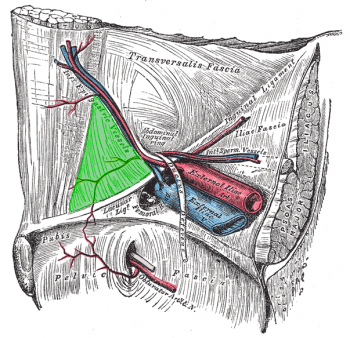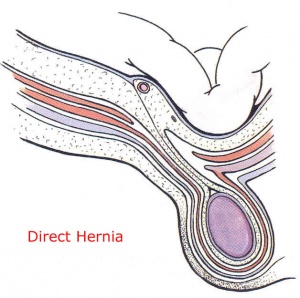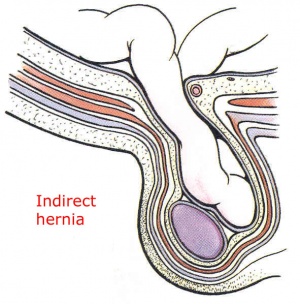Definition/Description
Inguinal hernias occur when soft tissue, usually intestines, protrudes from the abdominal cavity. There are two types of inguinal hernias that occur in the groin region – direct and indirect.[1]
A direct hernia occurs when a portion of the intestine protrudes directly outward through a weak point in the abdominal wall. This weak point could be caused by a deficiency in the number of transversus abdominus aponeurotic fibers. The inguinal triangle (Hesselbach’s triangle) is a common location for direct hernias to occur.[1] A direct inguinal hernia leaves the abdominal cavity medial to the inferior epigastric vessels.[2]
An indirect hernia occurs when a portion of the intestine pushes downward through the deep inguinal ring into the inguinal canal where the testes descend into the scrotum before birth (males) or to the labia (females) [1] An indirect inguinal hernia leaves the abdominal cavity lateral to the inferior epigastric vessels.[2]
Prevalence
Rougly 5 million Americans of all ages have some type of abdominal hernia. Inguinal hernias account for 75% of all hernias. They affect 2% of men in the United States. [1] It is estimated that approximately 25% of males and 2% of females will have an inguinal hernia during their lifetime. Children can also have inguinal hernias. The incident rate for children ranges up to 4.5%.[5] Direct inguinal hernias are more common in older adults, whereas indirect inguinal hernias occur more often in infants, males, and young people. [1] In general, indirect inguinal hernias are more common than direct inguinal hernias having a frequency that ranges from two-thirds to three-fourths of inguial hernias. [6]
In the United States, over 1 million abdominal hernia repairs are performed each year. Of those 1 million repairs, it is estimated that 770,000 of them are inguinal hernia repairs. Males receive 90% of all inguinal hernia repairs.[5]
Characteristics/Clinical Presentation
An inguinal hernia can present with the following signs and symptoms:
- Intermittent or persistent bulge in the groin [1]
- Pain or discomfort in the groin, especially when lifting, coughing, or bending[7]
- Weakness or pressure in the groin[7]
- Men can experience pain and swelling in the scrotum[7]
Inguinal hernias tend to be more noticeable following a heavy meal or after standing for a prolonged period of time. The pain associated with an inguinal hernia is usually sharp and localized. It can be heightened by changes in position, physical exertion, and with any activity causing the Valsalva maneuver.[1]
| Type | Location | Signs/Symptoms | Picture |
|---|---|---|---|
|
Direct Hernia |
It is typically located superior to the inguinal ligament, but behind and through the inguinal ring. It rarely enters the scrotum. |
|
|
|
Indirect Hernia |
The contained sac protrudes through the deep inguinal ring. The tissue can remain in the canal or pass into the scrotum (men) or labia (women). |
|
Associated Co-morbidities
Inguinal hernia may be associated with the following co-morbidities[9]:
- Congenital abdominal weakness
- Chronic constipation
- Chronic cough
- Enlarged prostate
- Cystic fibrosis
- Overweight, obesity, or pregnancy
- Ascites
- Smoking
- Overexertion
- Undescended testicles
- Any condition that increases pressure on the abdominal wall
Medications
Antibiotics are prescribed for strangulated hernias if ischemic bowel or infection is suspected. Over-the counter or prescribed medication for pain relief is utilized following surgical procedures[10].
Diagnostic Tests/Lab Tests/Lab Values
To diagnose an inguinal hernia, the doctor obtains a thorough medical history and conducts a physical examination. The patient will be asked to stand and/or cough as the doctor palpates the suspected hernia for movement. Typically, no diagnostic tests are necessary, but an ultrasound or CT scan may be utilized in some cases.
Etiology/Causes
| Risk Factors |
| 1. Abdominal wall defects 2. Advanced age 3. Ascites 4. Connective tissue disorders 5. Cystic fibrosis 6. Prematurity 7. Positive family history 8. Shunt for hydrocephalus 9. Undescended testis[1] |
Herniations can be caused by a multitude of factors. A direct inguinal hernia is caused by an acquired weakness such as obesity, pregnancy, muscle atrophy, chronic cough, ascites, heavy lifting, straining during bowel movements or urination, surgical incision, or blunt pressure from a trauma. An indirect inguinal hernia can be congenital or acquired.[1]
There are several factors that can predispose a person to a hernia such as situational stress, degenerative changes associated with an increase in abdominal pressure, producing several offspring during one gestation, altered collagen synthesis in middle age, and simply the wear and tear of the body over time. [1]
Systemic Involvement
Gastrointestinal – In the case of an inguinal hernia, abdominal contents protrude through a defect in the fascia. An inguinal hernia can become incarcerated, in which a piece of intestine or fat becomes trapped in the hernia opening and an obstruction occurs. In a strangulated hernia, the blood supply gets cut off and a portion of the intestine may die. Symptoms of a strangulated hernia or intestinal obstruction include pain, nausea, vomiting, inability to flatulate or have a bowel movement, fever, chills, and/or abdominal swelling. This is a medical emergency and requires immediate surgical treatment[11].
Cardiovasular – In the case of surgical hernia repair, complications from surgical intervention may include cardiac arrest, cardiac arrythmias, damage to blood vessels, excessive bleeding, and formation of blood clots[11].
Integumentary – Depending on the severity of protrusion, the various layers of the integumentary system may be affected. In this situation, typical presentation is redness and inflammation of the skin covering the hernia. Following inguinal hernia repair, wound management of the surgical incision is necessary to prevent infection and excessive scar tissue formation. Signs of infection include redness, swelling, pain, and discharge[10].
Reproductive – A long-standing inguinal hernia may negatively affect the microstructure of the testis and spermatic tract. Pressure or protrusion into the scrotum interrupts the thermoregulatory process of the testis and disrupts the production of sperm[12].
Medical Management (current best evidence)
If the hernia is small, it may be managed conservatively with activity modification and observation by the physician. However, if the intestines become trapped inside the hernia, it can be life threatening situation. Immediate surgery will be necessary in this case. Additionally, inguinal hernias that continue to enlarge or cause symptoms are treated surgically. In children, inguinal hernias are surgically repaired to prevent entrapment of abdominal contents from occurring. Inguinal hernia repairs are typically treated on an outpatient basis and will be surgically managed by one of the following methods[11]:
- Herniorrhaphy (Open hernia repair) – Local or general anesthesia is administered. The surgeon makes an incision in the groin, moves the hernia back into the abdomen, and reinforces the muscle wall with stitches.
- Laparoscopy – General anesthesia is administered. The surgeon inserts a laparoscope in the lower abdomen and repairs the hernia using synthetic mesh. Typically, patients experience a shorter recovery time and fewer complications.
- Hernioplasty – The area of muscle weakness is reinforced with a synthetic mesh or screen to provide additional support. This method may be utilized in open or laparoscopic repairs.
Medication is prescribed for pain management following surgery. Vigorous activity and heavy lifting are restricted for several weeks[10].
Physical Therapy Management (current best evidence)
Education – Physical therapists educate clients on work strategies, including body mechanics, proper breathing, and lifting techniques. By reducing strain and increased intraabdominal pressure, one may decrease the risk of developing a hernia or worsening an already existing hernia[1].
Screening – Obtaining a thorough medical history and conducting a physical examination is critical in determining the need for potential referral to a physician for diagnosis of an inguinal hernia. To palpate for an inguinal hernia, place hand at the location of the inguinal canal, superior to inguinal ligament and just lateral to the scrotum. Have the patient strain down or cough in standing to feel for a palpable mass [6].
Postoperative Rehabilitation – Often, patients are not seen for post-operative rehabilitation of an inguinal hernia repair. However, patients may require physical therapy services in order to return to prior level of function. A rehabilitation program will include posture exercises, education of proper body mechanics, and core strengthening. The program will be progressed as appropriate to include sport or work-specific functional activities[1].
Strapping Techniques (current best evidence)
With inguinal hernias that present with minimal symptoms, it is acceptible to watch and wait instead of opting for surgical repair. Supports and trusses can be used as a short term option to contain the hernia and prevent it from increasing in size. Also, there are strapping techniques available to contain the hernia; however, they are not recommended for use because the tape could cause an ulceration of the skin covering the hernia.[1]
During the acute phase when the hernia is small in size, it can be reduced by pushing it back in place. A person could manually push it back into place using their hands. If swelling is an issue, one could place ice over the affected area prior to pushing the contents back into the abdominal cavity. Additionally, one could lie with their pelvis higher than their head to assist them in pushing it back in place.[7]
Differential Diagnosis
It is critical to differentiate between an inguinal hernia and other conditions that may present with similar signs and symptoms[13][14] .
|
Condition |
Differentiating Signs and Symptoms |
| Undescended testis |
|
| Enlarged lymph nodes |
|
| Psoas abscess |
|
| Femoral aneurysm | |
| Epididymitis |
|
| Hydrocele |
|
| Femoral hernia |
|
| Athletic pubalgia |
|
Case Reports/ Case Studies
DeSantana JM, et al. Hypoalgesic Effect of the Transcutaneous Electrical Nerve Stimulation Following Inguinal Herniorrhaphy: A Randomized, Controlled Trial. The Journal of Pain [Internet]. 2008 [cited 2013 Feb 9]; 9(7): 623-629. Available from:
Pesanelli KE, Cigna JA, Basu SG, Morin AR. Occupational rehabilitation following open mesh surgical repair of an inguinal hernia. Phys Ther [Internet]. 2003 Jan [cited 2013 Feb 2]; 83(1): 58-66. Available from: Resources
Recent Related Research (from References
see adding references tutorial.
Ola!
Como podemos ajudar?





